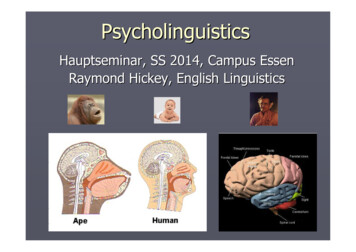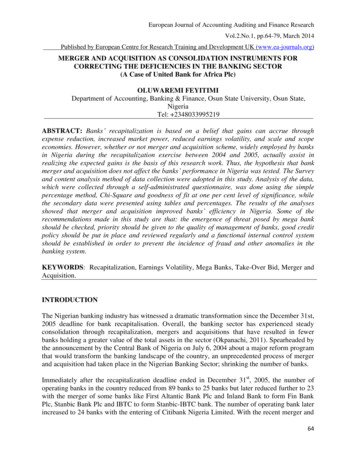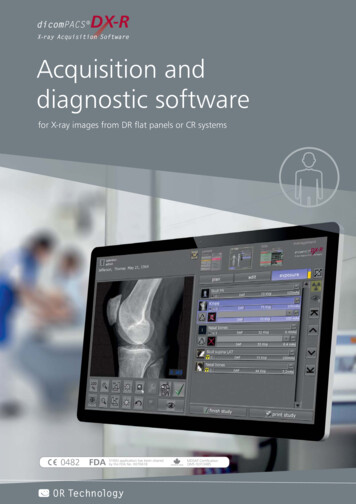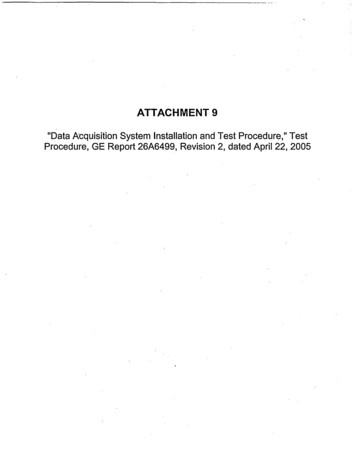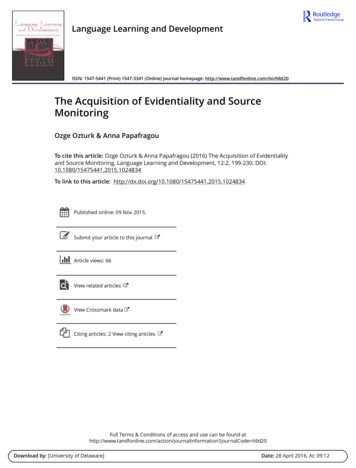
Transcription
Language Learning and DevelopmentISSN: 1547-5441 (Print) 1547-3341 (Online) Journal homepage: http://www.tandfonline.com/loi/hlld20The Acquisition of Evidentiality and SourceMonitoringOzge Ozturk & Anna PapafragouTo cite this article: Ozge Ozturk & Anna Papafragou (2016) The Acquisition of Evidentialityand Source Monitoring, Language Learning and Development, 12:2, 199-230, DOI:10.1080/15475441.2015.1024834To link to this article: lished online: 09 Nov 2015.Submit your article to this journalArticle views: 66View related articlesView Crossmark dataCiting articles: 2 View citing articlesFull Terms & Conditions of access and use can be found tion?journalCode hlld20Download by: [University of Delaware]Date: 28 April 2016, At: 09:12
LANGUAGE LEARNING AND DEVELOPMENT2016, VOL. 12, NO. 2, 024834The Acquisition of Evidentiality and Source MonitoringOzge Ozturka and Anna PapafragoubaDepartment of Linguistics and Cognitive Science, University of Delaware; bDepartment of Psychological and BrainSciences, University of DelawareDownloaded by [University of Delaware] at 09:12 28 April 2016ABSTRACTEvidentiality in language marks how information contained in a sentence wasacquired. For instance, Turkish has two past-tense morphemes that markwhether access to information was direct (typically, perception) or indirect(hearsay/inference). Full acquisition of evidential systems appears to be a lateachievement cross-linguistically. Currently, there are two distinct hypothesesabout why this is so. According to the first hypothesis, the acquisition ofevidentiality is delayed by conceptual factors related to source monitoring(the process of identifying and evaluating information sources). According to adifferent hypothesis, a substantial part of the learning difficulty comes frommapping evidential markers onto the underlying source concepts (even ifthese concepts are already available to the child), most likely because sourceconcepts do not correspond to observable referents in the world. Here wetested these two hypotheses in a series of experiments comparing the acquisition of evidential morphology (Experiments 1–3) and the development ofsource monitoring (Experiments 4–6) in the same group of Turkish-speakingchildren. We found that the semantics and pragmatics of evidential morphology in Turkish are not acquired until age 6 or 7. A comparison betweenlinguistic evidentiality and source monitoring experiments revealed that conceptual understanding of information access develops before the corresponding concepts are linked to evidential morphemes in Turkish, therebydemonstrating that mapping difficulties underlie the late acquisition of evidentiality in Turkish. Nevertheless, our data also suggest that conceptuallimitations play an important role in the acquisition of evidentiality, since inboth language and source monitoring direct evidence seems to be privilegedcompared to indirect evidence. This work has implications for the acquisitionof mental-state language and the relation between children’s linguistic andconceptual development.IntroductionThe development of the ability to produce and understand language is intimately connected to thelearner’s ability to entertain thoughts about the objects, relations, and events that language encodes.However, there is considerable debate about the precise relationship between linguistic and cognitivedevelopment. According to some commentators, the way children use (or fail to use) languagereveals whether children grasp or fail to grasp the underlying concepts; for instance, it has beenargued that the timetable of emergence of various expressions in child language more or less directlyreflects the degree of their conceptual complexity (see, e.g., Smiley & Huttenlocher, 1995; Gopnik &Meltzoff, 1997). Other researchers have proposed that what children say or do not say is determinednot only by what they can and cannot think about but also by the internal mechanics of languageCONTACT Anna Papafragouannap@udel.eduDelaware, Newark, DE 19716.Ozge Ozturk is now at Columbia University. 2016 Taylor & FrancisDepartment of Psychological and Brain Sciences, Wolf Hall, University of
Downloaded by [University of Delaware] at 09:12 28 April 2016200O. OZTURK AND A. PAPAFRAGOUacquisition that makes the discovery of the meanings for certain expressions easier than for others(Carey, 1982; Gleitman, 1990, among others).Here we address the relation between language acquisition and conceptual development byfocusing on evidentiality, that is, the linguistic encoding of the source for the information reportedin an utterance. In English, evidentiality is expressed through lexical means (I saw that it was rainingvs. I heard that it was raining), but in about one sixth of the world’s languages, evidentiality isgrammaticalized through specialized and often obligatory verbal affixes, particles, or other devices(see Aikhenvald & Dixon, 2001; Anderson, 1986; Chafe & Nichols, 1986; Cinque, 1999; Davis, Potts,& Speas, 2007; DeLancey, 2002; Faller, 2001, 2002; Garrett, 2000; Givón, 1982; de Haan, 1998, 2001;Ifantidou, 2001; Izvorski, 1998; Johanson & Utas, 2000; Lee, 2010; Matthewson, 2012; Mayer, 1990;McCready, 2008; McCready & Ogata, 2007; Mushin, 2001; Palmer, 1986; Papafragou, 2000;Sauerland & Schenner, 2007; Speas, 2004; Willett, 1988). For instance, in Turkish, for all past eventsencoded in a main clause, there is an obligatory choice between two verb suffixes, -DI and –mIş, thatdenote the direct versus indirect past (the two suffixes are realized as –di, -dı, -du, -dü, -ti, -tı, -tu, -tüand -miş, -mış, -muş, -müş respectively depending on phonological rules related to vowel harmonyand final devoicing; Aksu-Koc & Slobin, 1986; Johanson, 2003; Aikhenvald, 2004):(1) Çocuk oyun oynaChild game play‘The child played’(2) Çocuk oyun oynaChild game play‘The child played’-di.PAST. direct– mış.PAST. indirectMore specifically, –DI is the unmarked form for the past tense. Even though it can be neutral withrespect to information source, through the contrast with the indirect form, it is frequently used toconvey the information that an event was experienced first-hand (typically, through visual perception).The morpheme -mIş is the marked past tense form and indicates indirect access to an event—typically,through hearsay or inference.1 The past-tense morpheme –DI is vastly more frequent than –mIş inboth adult and child-directed speech (Ozturk, unpublished data). Choice of evidential in Turkish givesrise to pragmatic effects associated with speaker reliability, with the direct marker indicating greaterspeaker reliability or lack of reservations about the factuality of the event compared to the indirectmarker (Johanson, 2003).2 These two morphemes belong to a wider class of inflectional verb stemsuffixes in Turkish that encode voice, modality, negation, tense-aspect-mood and person/number(Turkish is an agglutinating language with a rich morphological system; Kornfilt, 1997).Even though little is known about how evidential systems are acquired, existing evidence (see nextsection) suggests that the acquisition of evidentiality poses significant challenges for learners. Tounderstand the nature of these challenges, one needs to know whether the learners’ difficulties liewith the linguistic items encoding evidentiality themselves or with the underlying source monitoringability to recognize and reason about sources of beliefs in oneself and others (usually referred to assource monitoring). Monitoring sources of information such as direct perception, verbal report, orinference interfaces in rather obvious ways with the ability to use evidential language. First, correctproduction of evidential markers presupposes the capacity to recognize and remember how onefound out about an event. Second, accurate comprehension of evidentiality requires attributing tothe speaker some type of information access. Third, there is an intuition that the direct/perceptionevidential markers generally indicate higher reliability compared to various indirect (e.g., hearsay,inferential) markers (compare I saw that. . . vs. I heard/inferred that. . ., or the Turkish direct/indirectpast distinction). This intuition is based on the fact that, other things being equal, first-hand access(e.g., visual perception) is ranked higher in the speaker’s consciousness than second-hand access(e.g., hearsay or inference); the same ranking has been observed in source reasoning studies (Koenig& Harris, 2005) and has a long philosophical tradition (Coady, 1992; Dancy, 1985; Fricker, 2006;Hume, 1748; Locke, 1689). However, these points of contact between linguistic evidentiality and
LANGUAGE LEARNING AND DEVELOPMENT201source monitoring have not been explored systematically. For instance, even though children’ssource monitoring has been extensively studied in the cognitive development literature, this strandof work has proceeded independently from work on the linguistic development of evidentiality.Furthermore, with few exceptions, the data on the development of source monitoring have so farcome from English-speaking populations rather than children acquiring languages with grammaticalized evidential systems.In what follows, we report a series of experiments with Turkish-speaking children investigatingboth the acquisition of evidential morphology and the development of source monitoring. Theexperiments were designed to reveal the relationships between linguistic and cognitive developmentin this domain. To introduce the specific hypotheses motivating our experimental work, in theremainder of the Introduction we review prior work on the development of evidentiality and therelationship between evidentiality and the corresponding nonlinguistic concepts.3Downloaded by [University of Delaware] at 09:12 28 April 2016The acquisition of linguistic evidentialityIn a pioneering study, Aksu-Koç (1988) explored the acquisition of the Turkish evidential system inchildren between the ages of 3 and 6. In one of her experiments, she presented children withscenarios in which an event (e.g., the popping of a balloon) was fully accessible to perception andother scenarios where it was possible to infer the occurrence of an event through some clues (e.g., thepopped balloon). Children were asked to describe the events. It was expected that directly perceivedevents should lead to the use of –DI, whereas inferred events should be described with –mIş. Resultsshow that young children do not appear to differentiate the two morphemes on the basis of theirevidential meaning: even 6-year-olds produced the correct morpheme only 72% of the time forwitnessed events and 68% of the time for nonwitnessed events. To test whether the two morphemeswere understood by young children, Aksu-Koç presented children with a sentence and asked them toguess which character in a story said it. Depending on the evidential marking of the sentence (–DI or–mIş), children were supposed to pick a character who had or had not witnessed the event. Youngerchildren performed at chance in this task. Even 6-year-olds were correct 71% of the time with –DIand only 56% of the time with –mIş.In another study, Aksu-Koç explored children’s knowledge of –mIş on its hearsay interpretation.Children listened to a sentence containing the direct marker –DI and were asked to report whathappened, thus having to convert the direct marker –DI into the indirect marker –mIş. On othertrials, participants directly experienced an event and were expected to report it using the directmarker –DI. Even the oldest children performed poorly in this task (although some features of thedesign complicate the interpretation of the results: Aksu-Koç, 1988, p. 159ff.). In sum, experimentalstudies on Turkish found that children’s production of evidentials was around chance levels beforethe age of 4 and was still nonadult-like by the age of 6, especially for the indirect marker; moreover,the ability to link the indirect marker to nonwitnessed events was poor even at the age of 6 (AksuKoc, 1988; for replications, see Ögel, 2007, summarized in Aksu-Koç, Ögel-Balaban, & Alp, 2009; cf.also Ozturk & Papafragou, 2007).4Cross-linguistic data add to the picture of how evidential systems are acquired. A study on theacquisition of Korean evidential markers found that 3-year-old children appear to have productivecommand of grammaticalized evidentials for direct evidence and verbal report but their comprehension of these morphemes is not stable (Papafragou et al., 2007; Choi, 1995). Moreover, 3- and 4-yearold Korean children are unable to conclude that hearsay statements are less reliable than statementswith the default evidential marker (Papafragou et al., 2007; Aksu-Koç & Alici, 2000 for related dataon Turkish). Comprehension tasks with Tibetan 2- to 5-year-olds show that children do not seem todifferentiate between the neutral and the indirect evidential marker (de Villiers, Garfield, Speas, &Roeper, 2007; de Villiers et al., 2009). Additional studies examined the ability of 3- to 6-year-oldJapanese children to adjudicate between information marked with particles encoding direct versusindirect evidence (Matsui, Yamamoto, & McCagg, 2006): only 6-year-olds performed differently
202O. OZTURK AND A. PAPAFRAGOUfrom chance, preferring utterances marked with direct evidence particles. Importantly, Japanesechildren succeeded earlier in a conceptually identical task involving particles encoding speakercertainty. Finally, Bulgarian 9-year-olds can use evidential markers about both how informationwas acquired and by whom to decide which of two utterances to believe, but 6-year-olds can only useinformation about source type (Fitneva, 2008; cf. Lee & Law, 2000 on Cantonese). Taken together,the cross-linguistic suggest that the acquisition of grammaticalized evidentiality is a late achievement.Downloaded by [University of Delaware] at 09:12 28 April 2016Conceptual versus mapping difficulties in the acquisition of evidentialityWhat might account for children’s difficulty with the acquisition of evidentiality? One possibility isthat the emergence of evidentials is delayed because of their abstract and complex conceptualpresuppositions. Specifically, it has been argued that children are initially more attentive to “concrete, referential and objective characteristics of situations” than to “subjectively relevant distinctionssuch as the speaker’s attitude to the proposition asserted” (Aksu-Koç, 1988, p. 195). Similarly, withinthe evidential class, the order of appearance of individual morphemes has been taken to reflect atleast in part the child’s developing abilities to handle various information sources. For instance, thefact that the indirect evidence morpheme appears later in Turkish child speech than the directevidence morpheme has been attributed to “the further complexity of making an inference. . . ascompared to simply accessing an experienced event from memory” (Aksu & Slobin, 1986, p. 165). Arelated explanation has been suggested for the fact that, in Turkish, the hearsay interpretation of theindirect evidential is acquired after the inferential interpretation (Alsu & Slobin, 1986). Suchproposals echo similar views in studies of early lexical development, where it is widely held thatmuch if not most of the difficulty in learning mental-state vocabulary comes from mastering therelevant concepts (Bartsch & Wellman, 1995; Gopnik & Meltzoff, 1997; Smiley & Huttenlocher,1995, on the acquisition of verbs such as think or know).According to an alternative hypothesis, the acquisition of linguistic evidentials poses mappingproblems for learners. On this hypothesis, children may be delayed in finding the correct meaningfor evidentials even if they have the underlying source concepts because discovering the correspondence between evidential language and concepts is complex. There are several factors that maycontribute to the language-to-concept mapping complexities. Most obviously, perhaps, evidentialmeanings do not correspond to observable referents in the world. Although at least some evidentialsconnect to external contingencies (e.g., witnessing an event, or hearing about an event in aconversation), the mentalistic notion of information access is only indirectly related to such contingencies. Similar difficulties have been observed in simulated learning environments with bothadults (Gillette, Gleitman, Gleitman, & Lederer, 1999; Snedeker & Gleitman, 2004) and children(Papafragou, Cassidy, & Gleitman, 2007) trying to acquire mental verbs such as think and know: themeanings of these verbs prove hard to glean from extra-linguistic (observational) circumstancesalone. In the case of Turkish evidentials, the mapping task becomes more complex by the fact thatthe forms used to communicate evidentiality also encode tense meanings (and need to be distinguished from other similar-sounding forms, see note 2). There may be other potential sources ofdifficulty during the mapping process, such as discovering the structure of the linguistic domain ofevidentiality (e.g., the number of evidential distinctions within the linguistic system).To evaluate the role of conceptual versus mapping factors in the acquisition of linguisticevidentiality, one would require independent evidence from source monitoring tasks. Overall,previous literature shows that source monitoring abilities develop over time, with visual perceptionbeing understood early as a knowledge source. For instance, even young children seem to grasp theconnection between seeing and knowing: 3-year-olds select the character who had visual access to anobject hidden inside a box as the one who knows what is hidden inside the box over anothercharacter who simply lifted or pushed the box (Pratt & Bryant, 1990; Pillow, 1989; but see Povinelli& deBlois, 1992; Wimmer, Hogrefe, & Perner, 1988, for different results in slightly more complextasks). Similarly, 3- and 4-year-olds are more likely to believe what they are told by an adult who has
Downloaded by [University of Delaware] at 09:12 28 April 2016LANGUAGE LEARNING AND DEVELOPMENT203had visual evidence over an adult who has not (Robinson, Champion, & Mitchell, 1998).Furthermore, it is recognized that visual perception (generally) offers reliable access to information:young children trust their own visual perception more than conflicting verbal reports from others(Mitchell, Robinson, Nye & Isaacs, 1996) and have higher confidence in the location or properties ofan object after seeing it for themselves over being told from a speaker (Clément, Koenig, & Harris,2004; Robinson, Haigh, & Nurmsoo, 2008).In contrast, young children may not always realize that verbal report leads to knowledge: 3- and4-year-olds have difficulty understanding that a person who has been verbally informed about thecontents of a box knows what is in the box (Wimmer, Hogrefe, & Perner, 1988; but Pratt & Bryant,1990). Relatedly, 3-year-olds do not understand that a person who has not heard a particularstatement is ignorant in relation to someone who has (Mossler, Marvin, & Greenberg, 1976; seealso Robinson, 1994; even though see Jaswal, 2010; Jaswal, Croft, Setia, & Cole, 2010). Youngchildren sometimes continue to believe an informant who has repeatedly misled them (Mascaro &Sperber, 2009).Finally, it has been argued that children do not fully realize that inference can be a source ofknowledge until at least the age of 6 (O’Neill & Gopnik, 1991; Pillow, 2002; Sodian & Schneider,1990; Sodian & Wimmer, 1987; Wimmer et al., 1988). In a study by Sodian and Wimmer (1987), thechild participant and one other observer were shown a transparent jar containing only blue balls. Asthe child watched, one ball was removed from the jar and placed in a plastic bag. The other persondid not witness this transfer but was told that there was a ball in the bag and that it had been takenfrom the jar. Four- and 5-year old children claimed that the other person did not know the ball’scolor. In contrast, 6-year-olds understood that the observer would be able to infer the color of theball in the bag without viewing it directly. Other studies have confirmed that 6-year-olds understandthe role of evidence: for instance, children of this age (unlike younger children) realize that peoplewith access to ambiguous visual (Taylor, 1988) or verbal (Sodian, 1988) information lack definitiveknowledge. Furthermore, 6- and 7-year-old children are able to recognize that evidence can providea basis for inference about unseen events; they are also able to evaluate the informativeness ofpotential evidence in deciding between a pair of hypotheses (Sodian, Zaitchik, & Carey, 1991).However, even children of this age do not always distinguish justified inference from mere guessingin others (Pillow, Hill, Boyce, & Stein, 2000).A separate strand of studies looking at children’s ability to justify their own knowledge in terms ofone of many potential sources has also found development of this ability between the ages of 3 and 5(even though 3-year-olds could reliably report how they knew about something; Gopnik & Graf,1988; O’Neill & Astington, 1990; O’Neill & Chong, 2001; O’Neill & Gopnik, 1991; Woolley & Bruell,1996). In these studies, children typically discover the contents of a container (e.g., they are allowedto see them, they are told, or they are shown a clue such as a thematically related object), and arethen asked how they found out. This procedure includes an initial training phase in which theexperimenter explicitly points out different sources of information to children (e.g., “This time I’mgoing to give you a clue so you can figure out what’s inside [. . .]”; O’Neill & Gopnik, 1991,Experiment 3), asks them about these sources and gives them feedback. These studies found thatinference was identified as a source later than perception and communication. Other tasks usingdeductive inference show that the tendency to explain one’s own knowledge by spontaneous appealto inference becomes robust only after the age of 5 (Sodian & Wimmer, 1987).Taken together, these results suggest that the source monitoring ability to recognize differentinformation sources and reason about them in oneself and others develops along a lengthy timetable.This finding seems to support the idea that the acquisition of linguistic evidentials is delayed becauseof the conceptual complexity of the underlying source concepts (rather than the intricacies ofmapping known source concepts onto grammatical items). It is likely that difficulties with verbalreport and inference impact the acquisition of reportative or inferential markers (such as the Turkish-mIş). However, given the variability of tasks used to test knowledge of grammaticalized evidentialityversus source monitoring, these conclusions can only be speculative.
Downloaded by [University of Delaware] at 09:12 28 April 2016204O. OZTURK AND A. PAPAFRAGOUA more direct way of teasing apart the contribution of conceptual and mapping factors to theacquisition of evidentiality would be to conduct source monitoring tasks of source reasoning withyoung language learners and compare results from such tasks to the same children’s knowledgeof linguistic evidentials. In an early study that took this approach, Papafragou et al. (2007)showed that 3- and 4-year-old Korean speakers who do not comprehend hearsay morphologyaccurately nevertheless succeed in identifying hearsay as a source of knowledge for themselvesand others. This result is important since it suggests that a critical part of the difficulty withevidential morphology in Korean is not due to conceptual factors (see also Matsui, Miura, &McCagg, 2006, for results on Japanese). However, this earlier study did not track the acquisitionof a full, obligatory evidential system (such as the Turkish system) but of an individual hearsaymorpheme, which is frequently (but not obligatorily) used to report prior speech. Relatedly, thestudy did not address a broader range of information sources (including inference). Moreover, itdid not trace the full developmental trajectory of either linguistic or conceptual evidentiality butrather focused on very young learners who had not yet fully acquired evidential morphology.Finally, the study used similar but not identical tasks to test linguistic versus conceptual sourceknowledge. Other studies have addressed the development of source monitoring in speakers ofTurkish but without using fully matched linguistic and nonlinguistic tasks (see Ozturk &Papafragou, 2007; Ögel, 2007, summarized in Aksu-Koç, Ögel-Balaban, & Alp, 2009; Lucaset al., 2013).Below we report findings from six experiments conducted with Turkish learners between the agesof 5 and 7 to probe further into the relationship between evidential language and source monitoring.We chose to look at somewhat older children, since earlier work indicated that 6-year-old Turkishlearners are still undergoing important linguistic development in the domain of evidential morphology. Three of our experiments test children’s acquisition of the semantics and pragmatics oflinguistic evidentiality (Experiments 1–3) and the remainder test the same children’s source monitoring abilities (Experiments 4–6). The linguistic experiments target the full range of evidentialmeanings (direct vs. indirect: hearsay/inference) encoded in the Turkish past tense system andattempt to chart their developmental timetable. The source monitoring experiments examine thecorresponding sources of information (direct evidence, i.e., perception, vs. indirect evidence, i.e.,verbal report or inference) and ask how children reason about these sources and calculate theirreliability. Task structure and difficulty are carefully matched across evidentiality and sourcemonitoring studies. As far as we know, this is one of the most systematic comparisons of linguisticand conceptual development available.Our overall goal is to contribute to theories of how evidentiality and source monitoring develop inchildren. Crucially, we are also interested in whether and how the conceptual basis of evidentialityconstrains the acquisition of evidential grammar. Two potential outcomes are of particular interest here.If children’s performance on source monitoring tasks turns out to be higher than their performance onthe corresponding linguistic evidentiality tasks, this will offer support for the role of mapping factors inthe acquisition of evidentiality. In contrast, if performance is tightly coupled between linguisticevidentiality and source monitoring tasks (and especially if, in both cases, there is an asymmetryfavoring direct over indirect sources, as suggested by prior work), this would reveal considerableinfluence of the source concepts on the developmental timetable of linguistic evidentials.General methodsParticipantsA total of 96 monolingual Turkish-speaking children participated. Children fell into three agegroups: 32 5-year-olds (mean: 5;10, range: 64–72 months), 32 6-year-olds (mean: 6;6, range: 73–84months) and 32 7-year-olds (mean: 7;8, range: 85–96 months).5 All children came from upper-
LANGUAGE LEARNING AND DEVELOPMENT205middle-class families and were recruited either from a preschool or a grade school in Istanbul,Turkey. Children were tested individually in a quiet room outside their classroom.Downloaded by [University of Delaware] at 09:12 28 April 2016Design overviewThree experiments measured children’s performance with linguistic evidentiality. These linguisticexperiments tested children’s production (Experiment 1) and comprehension (Experiment 2) ofevidential morphology, as well as the pragmatic ability to link evidentiality to speaker reliability(Experiment 3). An additional set of three experiments measured the same children’s performance in source monitoring tasks. These tasks tested children’s ability to report their own(Experiment 4) and others’ (Experiment 5) information sources, as well as the ability to relateinformation source to reliable knowledge (Experiment 6). Note that these three studies do notinvolve either interpreting or producing the critical evidential morphology, however, they doinvolve a verbal report component due to the nature of these tasks. Methodologically, thelinguistic evidentiality and source monitoring experiments were designed to be as parallel toeach other as possible. Theoretically, the two kinds of experiments were also tightly coupled inthe sense that each source monitoring experiment targeted the conceptual underpinnings of anaspect of evidentiality tested in a specific linguistic task: the ability to remember one’s owninformation sources (Experiment 4) is a prerequisite to producing linguistic evidentials appropriately (Experiment 1); the ability to remember others’ access to information (Experiment 5) isa prerequisite to attributing correct evidential language to speakers (Experiment 2); and theability to recognize that certain information sources are more reliable than others (Experiment 6)is a prerequisite to understanding that utterances marked for such information sources conveyhigher speaker reliability (Experiment 3).Across all linguistic evidentiality and source monitoring experiments, half of the childrenwithin each age group were randomly assigned to the See vs. Hear and the other half to the Seevs. Infer condition. The See vs. Hear group was tested on linguistic knowledge of the evidentialmarkers –DI and –mIş (on its hearsay interpretation) and on the conceptual understanding ofperception and communication. The See vs. Infer group was tested on linguistic knowledge of –DI and –mIş (on its inference interpretation) and on the conceptual understanding of perceptionand inference. (We did not include a Hear vs. Infer group because the same morpheme –mIş isused for both hearsa
also Ozturk & Papafragou, 2007).4 Cross-linguistic data add to the picture of how evidential systems are acquired. A study on the acquisition of Korean evidential markers found that 3-year-old children appear to have productive command of grammaticalized evidentials for direct evidence and verbal report but their comprehen-




